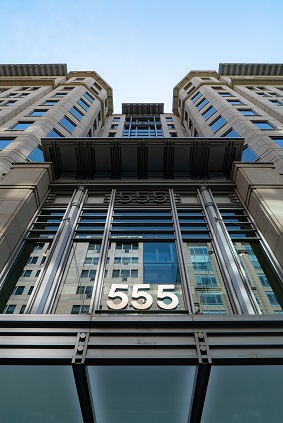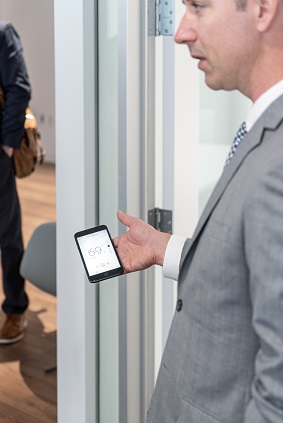How One System Integrator is Redefining Integration

Scott Hamilton,
Executive Vice President of Sales,
Distech Controls
|
August 2019 |
[an error occurred while processing this directive] |
|
Crafting a New
Tenant Experience How One System Integrator is Redefining Integration |
 Scott Hamilton, Executive Vice President of Sales, Distech Controls |
| Articles |
| Interviews |
| Releases |
| New Products |
| Reviews |
| [an error occurred while processing this directive] |
| Editorial |
| Events |
| Sponsors |
| Site Search |
| Newsletters |
| [an error occurred while processing this directive] |
| Archives |
| Past Issues |
| Home |
| Editors |
| eDucation |
| [an error occurred while processing this directive] |
| Training |
| Links |
| Software |
| Subscribe |
| [an error occurred while processing this directive] |
When
we think about smart buildings, we
often see the most visible parts first – the welcoming lobby, office
suite and rooms. It’s hard to miss the lighting illuminating the walls
and the audio-visual controls used for presentations. However, behind
the scenes, there is a lot going on. Many systems need to
seamlessly integrate (unify) in order to make a smart building
connected. It goes beyond embracing technology to actually
utilizing technology, in a sense helping the building meet its core
goals such as energy efficiency, facilities management and occupant
experience.
 Washington D.C.’s
District Center is the prime example of the building owner (MetLife
Investment Managements), the property manager and technical consultants (JLL), the agent that
sourced the
lighting and controls from Acuity Brands (Federated Lighting) and the
system integrator (SmartBT) all working together to accomplish these
goals and enable a future-ready building. Now that the upgraded
District Center has been operational for a few months, we checked in
with SmartBT, the project’s system integrator to hear from them
first-hand about the District Center project and what is next for
connected buildings.
Washington D.C.’s
District Center is the prime example of the building owner (MetLife
Investment Managements), the property manager and technical consultants (JLL), the agent that
sourced the
lighting and controls from Acuity Brands (Federated Lighting) and the
system integrator (SmartBT) all working together to accomplish these
goals and enable a future-ready building. Now that the upgraded
District Center has been operational for a few months, we checked in
with SmartBT, the project’s system integrator to hear from them
first-hand about the District Center project and what is next for
connected buildings.
Crafting a New Tenant Experience
Begins with a Rolling Start
According to SmartBT, the project
initially began as a simple building automation system upgrade to
control airflow through the use of variable air volume (VAV)
controllers, but once innovative ideas for the tenant experience
through digital technologies and applications were brought to the
table, the project evolved. “What began as a retrofit optimizing energy
efficiency and operational expenses became secondary to the project’s
newer goals – enhancing the occupant experience,” said Paul Meng,
Co-Principal with SmartBT.
Connected
building solutions were added to the project that enabled new occupant
focused feature sets. “As the project progressed, we moved from a
simple connection or integration of systems to actually unifying those
systems into one user interface,” said Journey Williams, VP of Smart
BT. SmartBT through use of IP technology, Distech Controls ECLYPSE
series controllers, the Eclypse Sky Ecosystem, and Acuity Brands nLight
Lighting Controls seamlessly deployed a scalable unified HVAC and
lighting control solution. This solution enables features
such as custom mobile app interfaces, single pane of glass graphical
user interface, single pane of glass LCD display room interfaces,
advanced room scheduling, indoor positioning and navigation. “They
[District Center] are one of the highest buildings in terms of energy
savings today, but the real value is what that single integration point
(unification) can yield in tenant services.” JLL's Smart Building Team
had worked wih Metlife Investment Management to create a vision for the
building that used a connected technology platform to increase value to
the
tenant in additiion to driving new operational efficiencies. JLL
enlisted SmartBT to guide them towards the applications and
solutions that would work for their specification and use case based
design.
Biggest Challenges & Wins
During the District Center Integration Project
With a reported 30% of building
management companies claiming to have already deployed a connected
building and another 60% considering it, these projects have many
challenges along with opportunities for success (Challenges
of
Implementing Connected Building Projects, An IDC Infographic,
Sponsored
by Acuity Brands).

SmartBT said their biggest
challenge with the District Center was that the specifications kept
evolving as the lights needed for the project kept evolving. This meant
that much of coordination and the various components were being
adjusted to meet the building requirements as they were specified.
SmartBT credits the technical team from Distech Controls and Acuity
Brands for being available to answer questions about the controls and
lights that arose as the deployment was occurring. Additionally,
SmartBT’s technical team worked with the engineers from Acuity Brands
and Distech Controls to work out the details in order to truly unify
the building systems. Sometimes there were requests by the client, and
all the engineers came together to “figure it out.” It was a proof of
concept (POC) made a reality.
IDC
Research on smart building
challenges indicates that the top challenge for decision-makers when
purchasing connected building solutions is their ability to evaluate
the technology in an operational scenario (at 44%). As a professional
integrator, SmartBT has worked with many of its customers who are
challenged with forecasting the future of their leasing space by
helping them understand how technologies will work in their commercial
buildings.
Meng says of the District Center
project, “We are just now experiencing our biggest wins.” The result
was hearing about the customer’s happiness with the project. SmartBT
was able to deliver amidst changes to the project’s scope because of
how the companies involved were able to work together, at times finding
and developing solutions. Now, with the initial challenges behind them
and the success of the District Center, SmartBT is confident this type
of project could go national to support an enterprise of businesses,
offering the same benefits from this connected building from a
commercial office on a larger scale. And, what’s nice is that the
unification worked out the “kinks.” It’s a repeatable process.
 Building Trust in the Process
Building Trust in the Process
For SmartBT, building a direct
relationship with the owners while also maintaining their relationship
with the specifiers and agents ensured the proper materials were
delivered based on the changing requirements. On both sides, trust was
built organically, but it took time to demonstrate that they would be
capable of keeping everyone’s interest and objectives for the project
in mind. The goal was to create a unified experience. SmartBT credits
are having a true partner in Federated Lighting that was adaptable and
could manage the project across the finish line. Also, having an onsite
SME well-versed in the project and end goals was beneficial. Onsite
meant that technical specifications had a chance to become cleared up
quickly. This allowed the project to go beyond the status quo.
What is in Store for the Future of
Connected Buildings?
As a system integrator, SmartBT has
confirmed the ambiguity of terms for connected. What one company
defines as a connected building can differ greatly from how another
company may define it. Commercial buildings outside of big-box
retailers are the first industry-leading up the curve towards
connecting and integrating their buildings. And, building systems and
technology are changing to the point that the platform opens doors for
building owners to consider more possibilities in their spaces. That’s
where the change happens in the conversation. “With the unification of
building systems, we can have a conversation that opens up the door as
the building solution group that can provide solutions as a group. It
is all the things you would expect so that a tenant can experience
this,” said Meng.
Energy rebates continue to provide
value, but SmartBT suggests that commercial building owners and
property managers are looking for insights and differentiators in
connected building solutions. That’s what keeps the building space
occupied. Today’s commercial buildings are interested in creating a
premium occupant experience in retrofit and modernization projects, so
they can command the most competitive rental prices per square foot and
get the most out of space utilization.
The Distech Controls “Unified
Project of the Year” award was presented to District Center in
Washington D.C. on Friday, June 28, 2019. To learn more about the
project and hear about this “fully functional smart building,” listen
to the ControlTalk NOW podcast episode.
About the Author
Scott Hamilton is the Executive Vice President of Sales for Distech
Controls. With more than 20 years of industry experience, Scott is
responsible for sales channels across the Americas, Australia and Asia,
as well as the organization’s OEM channel and Distech Controls Energy
Services.
[an error occurred while processing this directive]
[Click Banner To Learn More]
[Home Page] [The Automator] [About] [Subscribe ] [Contact Us]